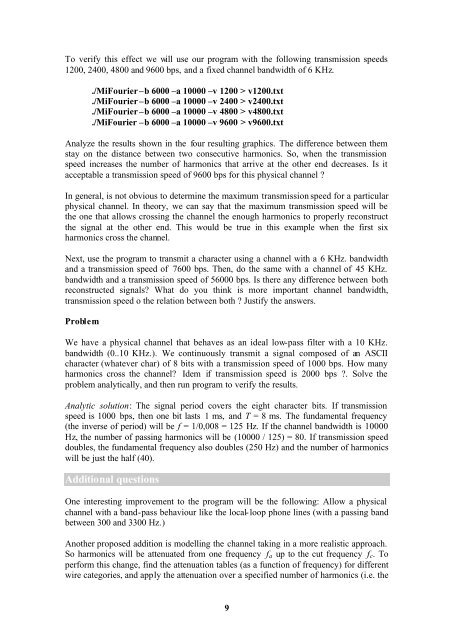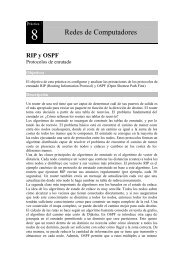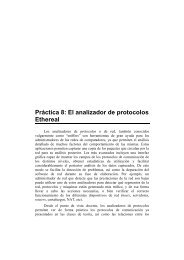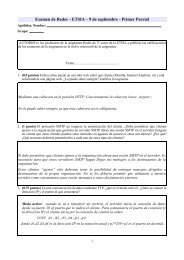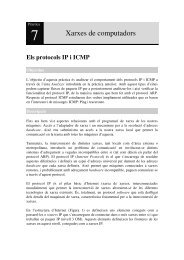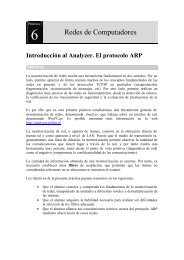Fourier Analysis - Redes de Computadores - UPV
Fourier Analysis - Redes de Computadores - UPV
Fourier Analysis - Redes de Computadores - UPV
Create successful ePaper yourself
Turn your PDF publications into a flip-book with our unique Google optimized e-Paper software.
To verify this effect we will use our program with the following transmission speeds<br />
1200, 2400, 4800 and 9600 bps, and a fixed channel bandwidth of 6 KHz.<br />
./Mi<strong>Fourier</strong> –b 6000 –a 10000 –v 1200 > v1200.txt<br />
./Mi<strong>Fourier</strong> –b 6000 –a 10000 –v 2400 > v2400.txt<br />
./Mi<strong>Fourier</strong> –b 6000 –a 10000 –v 4800 > v4800.txt<br />
./Mi<strong>Fourier</strong> –b 6000 –a 10000 –v 9600 > v9600.txt<br />
Analyze the results shown in the four resulting graphics. The difference between them<br />
stay on the distance between two consecutive harmonics. So, when the transmission<br />
speed increases the number of harmonics that arrive at the other end <strong>de</strong>creases. Is it<br />
acceptable a transmission speed of 9600 bps for this physical channel ?<br />
In general, is not obvious to <strong>de</strong>termine the maximum transmission speed for a particular<br />
physical channel. In theory, we can say that the maximum transmission speed will be<br />
the one that allows crossing the channel the enough harmonics to properly reconstruct<br />
the signal at the other end. This would be true in this example when the first six<br />
harmonics cross the channel.<br />
Next, use the program to transmit a character using a channel with a 6 KHz. bandwidth<br />
and a transmission speed of 7600 bps. Then, do the same with a channel of 45 KHz.<br />
bandwidth and a transmission speed of 56000 bps. Is there any difference between both<br />
reconstructed signals? What do you think is more important channel bandwidth,<br />
transmission speed o the relation between both ? Justify the answers.<br />
Problem<br />
We have a physical channel that behaves as an i<strong>de</strong>al low-pass filter with a 10 KHz.<br />
bandwidth (0..10 KHz.). We continuously transmit a signal composed of an ASCII<br />
character (whatever char) of 8 bits with a transmission speed of 1000 bps. How many<br />
harmonics cross the channel? I<strong>de</strong>m if transmission speed is 2000 bps ?. Solve the<br />
problem analytically, and then run program to verify the results.<br />
Analytic solution: The signal period covers the eight character bits. If transmission<br />
speed is 1000 bps, then one bit lasts 1 ms, and T = 8 ms. The fundamental frequency<br />
(the inverse of period) will be f = 1/0,008 = 125 Hz. If the channel bandwidth is 10000<br />
Hz, the number of passing harmonics will be (10000 / 125) = 80. If transmission speed<br />
doubles, the fundamental frequency also doubles (250 Hz) and the number of harmonics<br />
will be just the half (40).<br />
Additional questions<br />
One interesting improvement to the program will be the following: Allow a physical<br />
channel with a band-pass behaviour like the local-loop phone lines (with a passing band<br />
between 300 and 3300 Hz.)<br />
Another proposed addition is mo<strong>de</strong>lling the channel taking in a more realistic approach.<br />
So harmonics will be attenuated from one frequency fa up to the cut frequency fc. To<br />
perform this change, find the attenuation tables (as a function of frequency) for different<br />
wire categories, and apply the attenuation over a specified number of harmonics (i.e. the<br />
9


